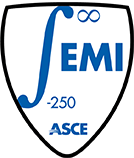Microstructure, Dynamics and Mechanics of Gels and Glasses
ETH Zurich
Problems
Gels and glassy materials, from rubbers to cement, are ubiquitous in engineering applications because they can combine efficient flow and transport with cohesion, strength and flexibility. The "smart" mechanics of these systems originates from the disordered, heterogeneous microscopic structure. The interplay of aggregation, arrested kinetics and cooperative dynamics are all a hallmark of amorphous solidification, where stress transmission is far from trivial. Yet, in order to translate these advances in glass physics into engineering applications a few key questions need to be addressed: Which microscopic processes during solidification are ultimately relevant for the behavior of these solids? What is the role of cohesion on microstructure; and how do external stresses affect this behavior? There is, at present, very limited understanding of these issues, which are of both scientific and practical importance.
Approach
We design coarse‐grained statistical mechanics models. Gels and glassy materials are described in terms of simplified units (i.e. nano‐scale particles) and effective interactions (i.e. specifically designed interaction potentials). While this approach is too coarse to account for all the chemical details that occur at multiple scales in the material, the statistical mechanics approach with its focus on particle interaction provides us with a means to investigate the structuring and solidification, from the nano‐ to the micro‐scale, in terms of collective and cooperative processes. More specifically, by means of Molecular Dynamics (MD) and Non Equilibrium MD simulations, we are able to assess and rationalize the local microscopic processes and structural features that determine the grain‐scale mechanical behavior.
Findings
The mechanical response of dense colloidal gels is found to vary by orders of magnitude upon varying the particle volume fraction. We have devised a hierarchical scheme to determine the elastic modulus of glassy colloidal suspensions. The approach reveals that the elasticity measured in experiments on such gels is dominated by the weak connections among large aggregates that form in the presence of cohesive interactions. We have used the same approach to investigate the shear‐induced solidification of dilute colloidal suspensions. Our calculations prove that shear stresses can change a stable nano‐particle suspension into a cohesive gel made of large fractal aggregates. With this new model for colloidal gelation, based on directional effective interactions, we have elucidated the complex cooperative dynamics of extremely dilute gel network: fast cooperative motion of local parts of the gel coexists with large scale, glassy rearrangements of the overall structure. The network nodes, i.e. the parts of the structure that are crucial to the mechanical stability, are involved in slow cooperative processes. In response to small deformations, studied model glasses exhibit, upon solidification, large correlated regions of non‐affine particle displacements, whose characteristic length size displays the same dramatic increase that are typical of critical phenomena.
Impact
One of the goals of this research is to understand how chemical modifications alter the mechanical behavior of gels and glasses. The models, tools and approaches developed for amorphous solids in this research provide access not only to the morphology of the complex microstructure, but also to the local microscopic processes that ultimately determine the overall mechanical and rheological response. As such, this research contributes to the sustainable design of gels and glasses, with a large range of applications, from cement gels to aerogels.
Core competencies
- Modeling of aggregation, cooperative processes and glassy dynamics.
- Mesoscopic modeling and multiscale analysis of amorphous materials.
- High performance computing and numerical simulations tools.
Current research team members
- Emanuela Del Gado (PI)
- Aikaterini Ioannidou (Ph.D. Candidate)
- Konrad Schwenke (Ph.D. Candidate)
- Jader Colombo (Postdoc)
Recent graduates and co‐workers
- Alessio Zaccone (co‐supervised PhD 2009) Oppenheimer Fellow, Cavendish Laboratory, University of Cambridge.
- Enrico Masoero ( ETH visiting PhD 2010) Post‐Doc Associate, Civil Engineering MIT.
Current research collaborations
- Micro‐structure and mechanics of model cement gels ‐ Roland J. Pellenq (CNRS and MIT‐CSHub), Sidney Yip, Franz J. Ulm (MIT‐CSHub)
- Consolidation of superplasticized cement pastes - Robert J. Flatt and Hans J. Herrmann (ETH Zurich)
- Glassy dynamics and assembly at interfaces‐ Lucio Isa, Patrick Ilg and Martin Kroeger (ETH Zurich), Erik Reimut (BOKU, Wien)
- Rheology of spinodal arrested networks - Thomas Gibaud (Brandeis), Peter Schurtenberger (Lund), Veronique Trappe (Fribourg)


